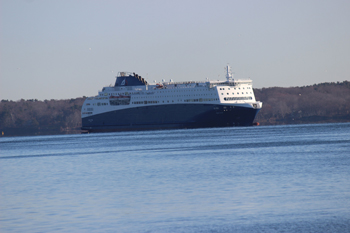Arrest of the Nova Star
by Nicholas Walsh, PA

The Nova Star, rolling with the tides while arrested at a mooring off Fort Allen Park at the foot of Munjoy Hill, Casco Bay, Portland, Maine, November 2015. The 528', Singapore-built cruise ship’s first year of service was 2014. It’s maximum passenger capacity is 1,215. Fishermen’s Voice photo
A few weeks ago Nova Star Cruises stopped paying its bills. The company ran a chartered 568-foot ferry, the Nova Star, between Portland and Halifax. Lienholders arrested the ship in Portland, and just a month later the action is nearly over. The arrest offers some important lessons in the law of maritime liens.
A maritime lien gives a provider of fuel, repair services etc. an automatic lien on the ship or boat to which the services were provided. The lien allows the provider to seize the ship in court and sell it in satisfaction of the lien. While the company, Nova Star Cruises, was certainly liable to pay for the fuel, laundry etc. that the ship had used, Nova Star Cruises has empty pockets, so far and away the most certain and probably only route to payment was through enforcement of a maritime lien.
The Portland Pilots brought their action to arrest the Nova Star in the Federal District Court in Portland. (Ship arrests are always brought in federal court, never in state court.) Whenever the Nova Star entered or left Portland Harbor, there was a pilot on board, provided by Portland Pilots, Inc. Certainly pilotage creates a maritime lien, and the Nova Star operation was in arrears to the Pilots for about $200,000. My client, World Fuel Services, then jumped on board – we were owed nearly half a million for bunker fuel.
When a ship is arrested to enforce a lien, other lienholders must join the action or they will lose their liens when the ship is auctioned off. The court requires publication of the arrest, with a warning to all lienholders – and any other person with an interest in the ship, such as the owner – that they must file in court to protect their interests.
There are two ways a lienholder can protect its lien. The easiest and cheapest approach is to file a verified lien statement with the court. For example, a marine contractor could simply write a letter to the court stating that he has a maritime lien for $5,000, stemming from repairs to the ship. The letter would be signed and, critically, it would be either “notarized” or it would bear the statement “signed under penalty of perjury.” A lawyer would do a fancier job, but that is in essence all a genuine lienholder has to do to make the sure the arresting court recognizes his lien, and that the lien gets paid when the ship is sold. A few of the smaller Nova Star lienholders did just that.
When a party
arrests a ship,
it assumes the
costs of taking care
of the ship.
My client took the second approach, which was to file its own civil complaint against the ship, asking for its own arrest even though the Portland Pilots had already arrested the ship. The “intervening complaint” was brought in the same action that was already before the court. We took this more complex and more expensive step because we were worried that the Nova Star or the ship’s owner might pay the Portland Pilots in full, resulting in the Pilots’ arrest being dismissed. The Nova Star could then steam out of Portland Harbor, and we’d have to chase her down in some other port, maybe one across the world, before we could get the ship arrested again. With our own arrest in the back pocket we knew that couldn’t happen.
Lots of other lienholders then joined the fun, including another fuel supplier, chandlers, tug companies, and Pratt Abbott, the supplier of laundry services to the ship. Some filed intervening complaints and others, particularly those not owed all that much, filed verified statements of claim. Meantime the ship sat on the hook in Portland’s Anchorage A, her crew still on board.
When a party arrests a ship it assumes the costs of taking care of the ship. In the case of the Nova Star, costs of shipkeeping ran about $3,500 a day. As other parties appeared, the court ordered the additional lienholders to share in the cost of shipkeeping, in proportion to the size of the asserted liens. That’s the law.
Then the ship’s owner appeared, checkbook in hand, and it wanted its chartered ship back. The owner settled with all the certain lienholders; my client is out, happy with the result. Several parties claiming to have maritime liens are still in, including another fuel supplier and the laundry. The owner, I understand, is not completely certain that the fuel for which a lien is claimed was loaded on this ship – or something like that – and apparently it disputes that provision of commercial laundry services to a cruise ferry creates a maritime lien, or at least a lien in the amount claimed, which I understand includes the fabrication of special laundry carts sized to the ship’s passageways.
For my part, I’d say the laundry has the better argument. A maritime lien is created when a contractor provides a ship with labor or services necessary to the ship’s commercial mission. You can’t run a cruise ferry without clean sheets, nor without special laundry carts if those are required. I think the laundry gets its lien.
Nicholas Walsh is an attorney practicing in Portland. He may be reached at (207) 772-2191, or at nwalsh@gwi.net.
